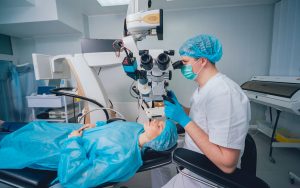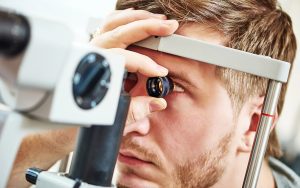How Does Alcohol Affect Vision and Eye Health?

Excessive alcohol consumption is associated with blacking out, hangovers, and generally poor health. However, it also affects vision. Alcohol affects the nerves and blood vessels in the eyes, thus affecting vision.
Alcohol consumption has been associated with eye damage due to abnormal blood flow (retinopathy) and nerve damage (optic neuropathy), leading to vision decline or total vision loss.
To understand the effects of alcohol on our vision, you must first understand different blood alcohol levels.
What Are the Different Blood Alcohol Levels?
To understand the amount of alcohol required to affect vision, we first must discuss alcohol blood levels.
A unit called blood alcohol concentration (BAC) outlines the amount of alcohol you take. BAC is expressed as a percentage in that 1% BAC means the individual has one alcohol molecule against 99 blood molecules.
At 0.05% to 0.07% BAC, individuals feel ‘tipsy.’ Then at 0.08% to 0.09%, individuals experience reductions in physical coordination and should not drive. At 0.10% to 0.14%, individuals experience a loss of coordination and judgment. At this stage, blurred vision sets in.
At 0.15% to 0.19% BAC, motor functions, balance, and vision are impaired. Individuals experience significantly blurred vision. At 0.20% and above, individuals are severely intoxicated and may experience loss of consciousness. In extreme cases, some slip into a coma and even die due to respiratory failure.
What Are the Effects of Alcohol on Vision?
The effects of alcohol on vision can be short-term (appear immediately after drinking and disappear after sobering up) or long-term (after consuming alcohol for an extended period).
Short-term
Blurred or double vision
Individuals may experience the typical blurred vision where objects, texts, or faces may be challenging to identify.
Glare sensitivity
Heavily intoxicated individuals may develop sudden sensitivity to glare or bright lights.
Reduced night-time vision
Studies showed that alcohol reduced vision in low-illumination environments, especially at night. Reduced night vision also comes with blurred vision.
Long-term
Blurred vision
According to the American Academy of Ophthalmology, heavy drinking has also been associated with Central serous chorioretinopathy (CSCR), fluid accumulation in the retina leading to vision distortion.
CSCR is associated with dimmed or blurred vision, dark areas in central vision, and a distorted sense of object sizes.
Abnormal eye movement
Alcohol is considered a neurotoxin that damages the eyes, leading to Age-related Macular Degeneration (AMD). AMD affects sharp and straight-ahead vision with aging. Chronic alcohol abusers are likely to develop AMD as alcohol damages the macula (part of the eye that is light sensitive.)
Individuals who consume alcohol are more likely to develop AMD that progressively gets worse leading to blindness in some cases.
Heavy drinkers who smoke and have poor dietary lifestyles are also likely to develop alcoholic amblyopia, a rare case of bilateral vision loss.
Reduced color sensitivity
Alcohol consumption is also associated with color vision defects (dyschromatopsia) as it damages some ocular nerves. Heavy drinkers may have a more challenging time distinguishing between different colors.
Glaucoma
Scientific studies have shown that heavy drinkers are likely to develop glaucoma, a group of conditions that damage the optic nerves. Glaucoma is linked to high pressure in the eyes. It causes vision loss (temporary or permanent in severe cases), eye pain, and redness.
Cataracts
Alcohol consumption has been associated with increased risks of developing age-related cataracts. Alcohol in the blood moves to the eyes affecting their function. It can lead to the accumulation of molecules in the lens causing cataract formation.
Dry eyes
Heavy alcohol consumption has been associated with dry eyes syndrome, where they cannot adequately lubricate themselves. Alcohol can be found in tears leading scientists to conclude that it affects the quality of the tears by diminishing their lubricating capabilities.
Fetal alcohol syndrome
Fetal alcohol syndrome (FAS) is a condition babies develop when pregnant mothers abuse alcohol. FAS increases the chances of unborn babies developing mental and physical defects such as eye diseases.
Alcohol abuse by the mother during pregnancy is associated with physical deformities in the eye structures. Scientists have noted that over 90% of FAS babies are likely to have poorly developed eyes, nerves, and eye blood vessels, severely affecting their vision.
Methanol-induced vision loss
Alcoholic beverages such as beer, wine, and distilled spirits contain ethyl alcohol or ethanol. Though rare, deceitful alcohol makers can use methanol in place of alcohol as they physically appear similar. However, a small amount of methanol consumption can lead to permanent vision loss if diagnosed late.
Methanol reacts with normal biological eye processes, leading to permanent damage of vital nerves that send images to the brain. Even with treatment, over 30% of individuals will still have some permanent damage.
Is There Treatment or Prevention?
Short-term effects of alcohol on vision clear on their own as you sober up. However, long-term conditions require treatment by ophthalmologists.
There is no single treatment, so individuals receive treatment depending on their symptoms. Researchers have noticed that heavy drinkers are likelier to have low levels of protective nutrients such as zinc and vitamins (B12 and folate).
So, adding these protective nutrients to your diet can reduce the chances of developing eye diseases such as AMD.
Moderate alcohol consumption may improve vision.
Low to moderate alcohol consumption may prevent some eye diseases such as central retinal vein occlusion (RVO), the blockage of eye veins.
Another study in the UK also noted that low to moderate wine consumption might protect against cataracts. However, it may not protect against all associated eye complications, such as dry eyes. Studies also show better distance vision in moderate drinkers than in heavy drinkers.
Our Recommendation
Heavy drinkers may not notice eye damage until symptoms become severe. The first sign is often a decrease in vision sharpness. However, the damage is near permanent at this point, and symptoms will progress with continued alcohol consumption.
Ophthalmologists consider alcohol consumption a modifiable risk factor, meaning individuals can prevent alcohol vision decline by limiting or stopping consumption.
We recommend an eye check-up if you are an active drinker. We will set up a plan and treatment options to sustain and improve your vision.




